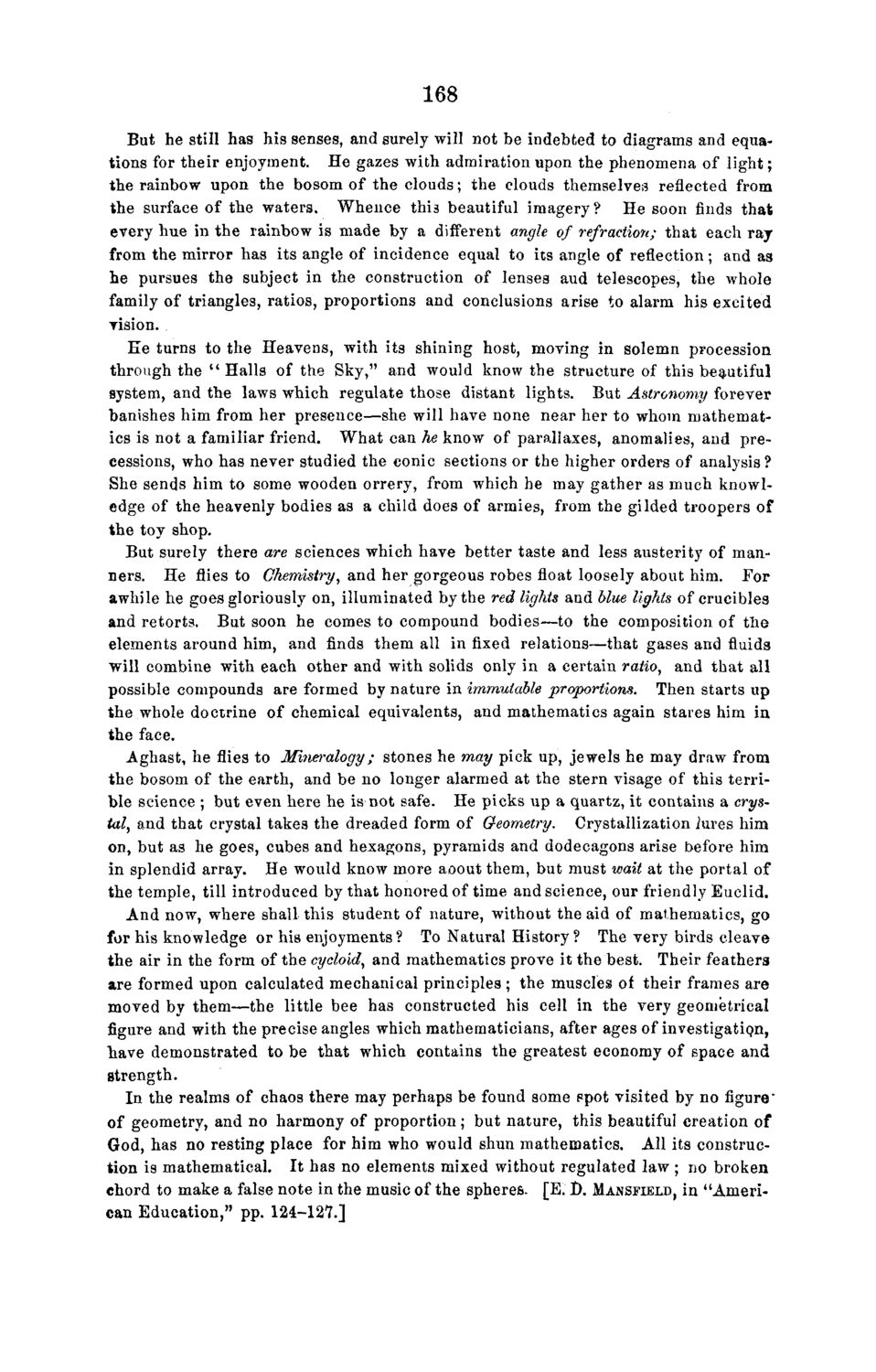| |
| |
Caption: Board of Trustees Minutes - 1868
This is a reduced-resolution page image for fast online browsing.

EXTRACTED TEXT FROM PAGE:
168 But he still has his senses, and surely will not be indebted to diagrams and equations for their enjoyment. He gazes with admiration upon the phenomena of light; the rainbow upon the bosom of the clouds; the clouds themselves reflected from the surface of the waters. Whence this beautiful imagery ? He soon finds that every hue in the rainbow is made by a different angle of refraction; that each ray from the mirror has its angle of incidence equal to its angle of reflection; and as he pursues the subject in the construction of lenses aud telescopes, the whole family of triangles, ratios, proportions and conclusions arise to alarm his excited vision. He turns to the Heavens, with its shining host, moving in solemn procession through the "Halls of the Sky," and would know the structure of this beautiful system, and the laws which regulate those distant lights. But Astronomy forever banishes him from her presence—she will have none near her to whom mathematics is not a familiar friend. What can he know of parallaxes, anomalies, and precessions, who has never studied the conic sections or the higher orders of analysis? She sends him to some wooden orrery, from which he may gather as much knowledge of the heavenly bodies as a child does of armies, from the gilded troopers of the toy shop. But surely there are sciences which have better taste and less austerity of manners. He flies to Chemistry, and her gorgeous robes float loosely about him. For awhile he goes gloriously on, illuminated by the red lights and blue lights of crucibles and retorts. But soon he comes to compound bodies—to the composition of the elements around him, and finds them all in fixed relations—that gases and fluids will combine with each other and with solids only in a certain ratio, and that all possible compounds are formed by nature in immutable proportions. Then starts up the whole doctrine of chemical equivalents, and mathematics again stares him in the face. Aghast, he flies to Mineralogy; stones he may pick up, jewels he may draw from the bosom of the earth, and be no longer alarmed at the stern visage of this terrible science ; but even here he is not safe. He picks up a quartz, it contains a crystal, and that crystal takes the dreaded form of Geometry. Crystallization iures him on, but as he goes, cubes and hexagons, pyramids and dodecagons arise before him in splendid array. He would know more aoout them, but must wait at the portal of the temple, till introduced by that honored of time and science, our friendly Euclid. And now, where shall this student of nature, without the aid of mathematics, go for his knowledge or his enjoyments ? To Natural History ? The very birds cleave the air in the form of the cycloid, and mathematics prove it the best. Their feathers are formed upon calculated mechanical principles ; the muscles of their frames are moved by them—the little bee has constructed his cell in the very geometrical figure and with the precise angles which mathematicians, after ages of investigation, have demonstrated to be that which contains the greatest economy of space and strength. In the realms of chaos there may perhaps be found some spot visited by no figure* of geometry, and no harmony of proportion; but nature, this beautiful creation of God, has no resting place for him who would shun mathematics. All its construction is mathematical. It has no elements mixed without regulated law ; no broken chord to make a false note in the music of the spheres. [E. D. MANSFIELD, in "American Education," pp. 124-127.]
| |